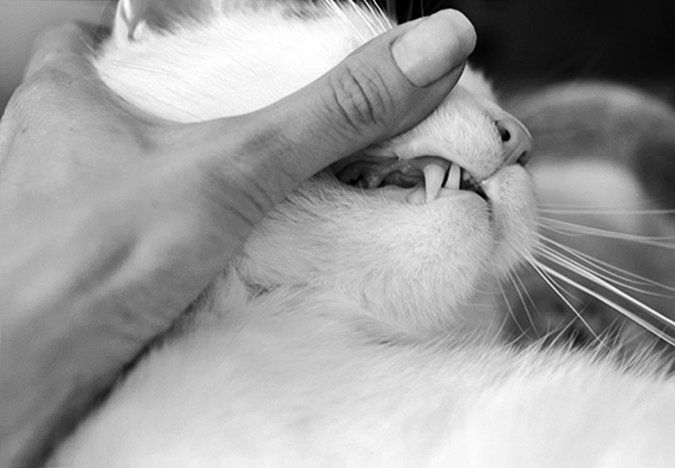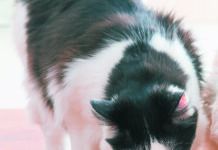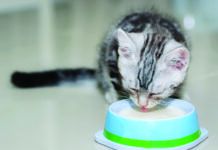THINKSTOCK
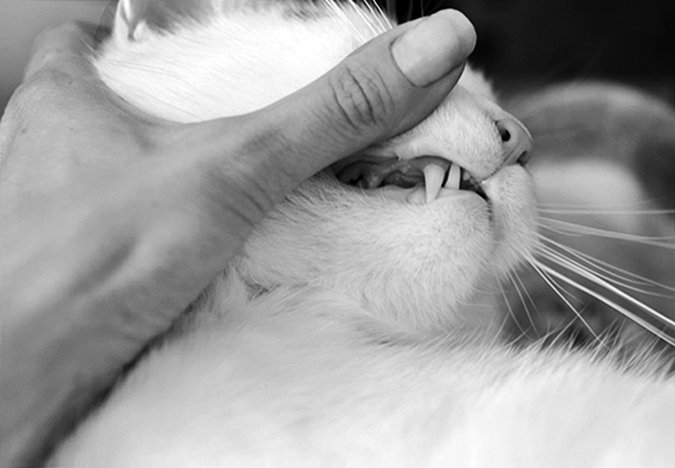

Cats in general are very good at concealing the outward signs of illness. Eons of experience in the wilderness have taught them to be wary of revealing any debilitating physical disorder that might signal their vulnerability to a potential predator. This is certainly the case when it comes to feline dental disease.
While a cat may be in pain — his gums inflamed and swollen, some of his teeth so loose that they are about to fall out — the animal may well go on with his normal activities until a veterinary checkup reveals the disorder and the extent of its progression.
Dental disease is common
Such dental problems are by no means rare; indeed, various studies have indicated that anywhere from 65 percent to 90 percent of today’s domestic cats will experience a significant tooth or gum disorder at some point in their lives. In some cats, an elevated risk for dental disease may be genetically inherited. In others, the problem may be largely attributable to — or at least exacerbated by — the failure of a cat’s owner to routinely monitor and provide cleaning of the cat’s teeth.
Whatever the cause, the onset and progression of feline dental disease is more likely to occur in a cat whose owners fail to provide him with a diet that includes the nutritional ingredients known to help maintain overall dental health.
“While there is no magic formula for the perfect diet, unbalanced diets can certainly contribute to dental disease,” notes Cailin Heinze, VMD, assistant professor of nutrition in the department of clinical sciences at the Cummings School. “For example, a mature cat’s daily diet must contain adequate amounts of components such as vitamin D, calcium and phosphorous, which foster and maintain bone development. Dietary deficiencies of these essential nutrients can certainly contribute to dental disease — they can definitely affect the integrity of the jawbone, in which a cat’s teeth are anchored.”
During their gestation and the period immediately following birth, kittens — which are born toothless — get these necessary dietary components from mother’s milk. They will eventually grow two sets of teeth during their lifetimes. The first set comprises 26 deciduous teeth, otherwise known as milk teeth. The milk teeth start to appear when a kitten is about four weeks old, and by six weeks of age, the full complement is normally present.
By the time the kitten is six months old or so, the deciduous teeth will have fallen out and been replaced by 30 permanent teeth — 16 upper and 14 lower.
Teeth with different functions
Collectively, the permanent teeth are shaped and arranged in the mouth to accommodate a cat’s carnivorous needs and desires, like catching prey, ripping it to pieces and chewing it up. There are four types of teeth: incisors, canines, premolars and molars. Each type differs in shape and size according to its principal predatory function. The incisors, located at the front of the mouth — six upper and six lower — perform a nipping function. Next in line are the canines (or fangs) — two upper and two lower — that are good for grasping and puncturing.
Behind the canines are the premolars — six upper and four lower—that are built for gripping. And, at the back of the mouth, are the molars — two upper and two lower — which are used for grinding. Inside each tooth is a chamber (the root canal) that contains tissue — made up of blood vessels, lymphatic vessels and nerves — that communicates with the rest of a cat’s body.
The pulp tissue in this chamber is surrounded by a bony tissue called dentin, which accounts for the bulk of a tooth’s structure. And covering the crown of the tooth (its outer surface above the gumline) is a layer of enamel, which protects the dentin. All of the tissues that constitute a cat’s tooth are vulnerable to disease, injury, and routine wear and tear.
Two types of feline dental disease make up the vast majority of serious conditions affecting the teeth or the areas around the teeth. Most common is periodontal disease, which affects an estimated 85 percent of cats over the age of six. In this disease, layers of plaque and tartar — accumulations of bacterial microorganisms — harden on a tooth’s surface.
Bacterial poisons and enzymes from the plaque eventually prompt an inflammatory response in the gums (gingiva) that, if left untreated, leads to severe gum inflammation (gingivitis). In cats, advanced periodontal disease can quickly progress to an end-stage condition for which extraction is the only reasonable treatment option.
The other comparatively common dental disorder is feline odontoclastic resorptive lesions (FORLs), a condition that affects an estimated 50 percent of cats. This disease is characterized by plaque-caused lesions that start in the dentin and can progress rapidly to irreparably damage an affected tooth and its root. If this disease has extended to the point at which the lesions pose a threat to the pulp chamber — the soft central portion of a tooth — the tooth must be extracted.
Is dry food better?
Regarding the relative benefits of commercially available hard versus soft cat foods, Dr. Heinze believes that most are satisfactory in terms of sustaining a cat’s general well-being. “But I don’t think you can say that, across the board, all dry foods are better than all canned foods, or vice versa,” she says. “However, there are a few products that have been designed specifically to promote dental health, and most — but not all — are therapeutic diets that have been developed under the guidance of veterinarians. Many of them have been through clinical trials that have demonstrated their benefit specifically to dental health.”
Approved dental products
Dr. Heinze encourages owners to consider the recommendations published by the Veterinary Oral Health Council (VOHC), which evaluates commercial cat foods to determine whether they meet the standards necessary to control plaque and tartar. (These approved brands are listed on page 4, or can be accessed on the organization’s website at www.vohc.org.)
“If a product has this seal,” says Dr. Heinze, “you can assume that it is proven to have some efficacy in reducing plaque or tartar. Otherwise, there’s no way to know whether that food, treat or supplement will be of any benefit. There are certain things you can say on a label but don’t have to prove.”
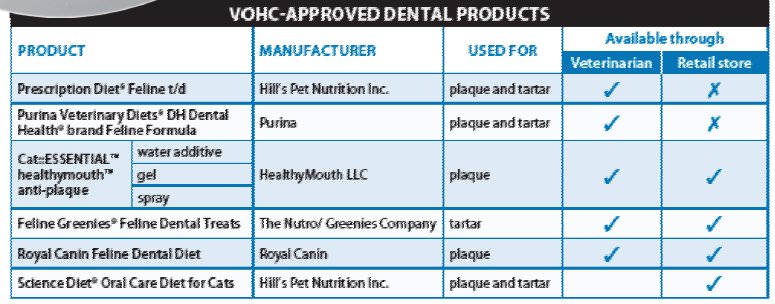

Brush, brush, brush!
In addition to providing a diet that is likely to retard the buildup of plaque and tartar, owners are also advised to get in the habit of brushing a cat’s teeth every day or so, since dangerous bacteria can colonize on a cat’s teeth within a matter of hours after eating.
Owners can receive instruction from a veterinarian or veterinary technician on how to brush a cat’s teeth — as well as on the type of brush and veterinary toothpaste that should be used. In addition, owners should have their cat’s teeth and oral cavity examined regularly by a veterinarian or a veterinary dentist.

